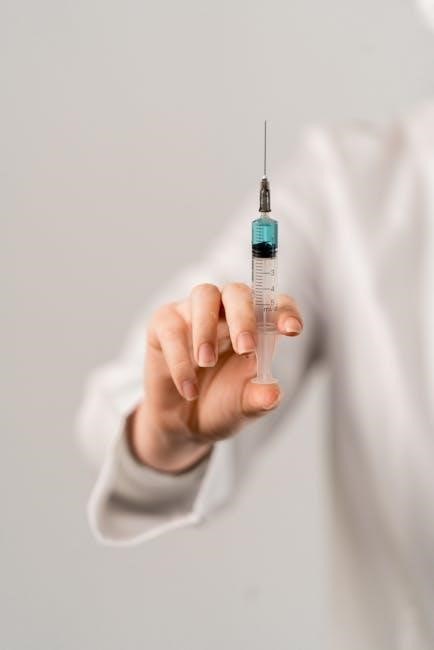ultrasound needle guide

An ultrasound needle guide is a medical device used to enhance precise needle placement during minimally invasive procedures‚ utilizing real-time imaging for accurate tissue targeting and diagnosis.

What is an Ultrasound Needle Guide?

An ultrasound needle guide is a specialized medical device designed to assist in precise needle placement during ultrasound-guided procedures. It typically attaches to the ultrasound transducer‚ providing a channel to guide the needle toward the target tissue. This tool enhances the accuracy of minimally invasive procedures‚ such as biopsies or fluid aspirations‚ by ensuring proper alignment and reducing complications. The guide allows healthcare professionals to visualize the needle’s path in real-time‚ improving control and safety. Its design varies depending on the procedure‚ but its primary function remains consistent: to facilitate accurate and efficient needle placement under ultrasound imaging. This technology has become essential in modern medicine‚ particularly for diagnosing and treating conditions requiring precise intervention.
Types of Procedures Using Ultrasound Needle Guides
Ultrasound needle guides are commonly used in biopsies‚ fluid aspirations‚ and pelvic procedures‚ ensuring precise needle placement for diagnostic and therapeutic interventions.
Biopsy and Fluid Aspiration Procedures
Ultrasound needle guides are invaluable in biopsy and fluid aspiration procedures‚ enabling precise targeting of tissues or fluid pockets. By providing real-time imaging‚ they enhance accuracy‚ minimizing complications and ensuring safe sample collection. These guides are particularly useful in abdominal‚ pelvic‚ and vascular procedures‚ where visibility is crucial. The ability to visualize the needle’s trajectory reduces the risk of damaging surrounding structures‚ making the process safer for patients. This technology is especially beneficial in diagnosing conditions like liver or kidney issues‚ where accurate tissue sampling is critical. Overall‚ ultrasound needle guides significantly improve the efficiency and reliability of biopsy and fluid aspiration procedures‚ contributing to better patient outcomes.

How Ultrasound Needle Guides Work
Ultrasound needle guides use sound waves to create real-time images‚ helping healthcare providers precisely locate and direct needles during medical procedures without invasive methods or radiation.

Real-Time Imaging for Precise Needle Placement
Real-time imaging provided by ultrasound needle guides allows healthcare professionals to visualize the needle’s position and target tissue simultaneously during procedures. This technology enhances accuracy by enabling precise tracking of the needle’s trajectory‚ reducing the risk of complications. The high-resolution images generated by the ultrasound system provide clear anatomical detail‚ helping guide the needle to the exact location. This capability is particularly beneficial in minimally invasive procedures‚ such as biopsies or fluid aspirations‚ where avoiding surrounding structures is critical. The real-time feedback ensures that the needle is placed correctly on the first attempt‚ minimizing discomfort for the patient and improving procedural efficiency. This advanced imaging capability is a cornerstone of modern ultrasound-guided interventions‚ making them safer and more effective for diagnosing and treating various medical conditions.

Benefits of Using Ultrasound Needle Guides
Ultrasound needle guides offer enhanced precision‚ reducing complications and improving patient outcomes. They enable real-time visualization‚ minimizing errors and optimizing diagnostic accuracy during procedures.

Improved Accuracy and Reduced Complications
The use of ultrasound needle guides significantly enhances the accuracy of needle placement‚ which is critical for procedures like biopsies and fluid aspirations. By providing real-time imaging‚ these guides allow practitioners to visualize the needle’s trajectory and target tissues with precision. This reduces the risk of complications‚ such as accidental puncture of vital structures or multiple needle passes. The immediate feedback offered by ultrasound guidance also minimizes procedural time‚ improving patient comfort. Additionally‚ the reduction in complications leads to shorter recovery times and fewer post-procedural care requirements. Overall‚ ultrasound needle guides play a pivotal role in advancing the safety and efficacy of minimally invasive medical interventions.

Challenges and Limitations
Technical challenges include operator dependency‚ image resolution limitations‚ and difficulty in visualizing deep or complex tissues‚ which can affect procedure outcomes and accuracy.
Technical and Clinical Challenges in Guided Procedures
Ultrasound needle guides face challenges such as operator dependency‚ requiring skilled professionals for accurate placement. Image resolution limitations can obscure deep tissues or small structures‚ complicating procedures. Patient movement and respiratory artifact may disrupt real-time imaging‚ potentially leading to inaccuracies. Additionally‚ tissue density and calcifications can hinder sound wave transmission‚ reducing visibility. Equipment compatibility and probe limitations further constrain the system’s effectiveness. These factors highlight the need for advanced training and technological advancements to overcome such hurdles and ensure reliable outcomes in guided interventions.
Clinical Applications of Ultrasound Needle Guides
Ultrasound needle guides are widely used for biopsies‚ fluid aspirations‚ and injections‚ particularly in abdominal‚ pelvic‚ and vascular procedures‚ aiding in precise tissue targeting and diagnosis.
Abdominal‚ Pelvic‚ and Vascular Procedures
Ultrasound needle guides are extensively used in abdominal‚ pelvic‚ and vascular procedures to ensure precise needle placement. In abdominal procedures‚ they assist in targeting organs like the liver‚ kidneys‚ and pancreas for biopsies or fluid aspiration. Pelvic applications often involve guiding needles for gynecological interventions or drainage of cysts. Vascular procedures benefit from real-time imaging to access blood vessels safely‚ such as during dialysis fistula creation or central line placements. The ability to visualize anatomy in real-time enhances diagnostic accuracy and minimizes complications. These applications highlight the versatility of ultrasound needle guides in diverse clinical settings‚ making them indispensable tools for modern medicine.
Future Trends in Ultrasound Needle Guidance

Future trends include AI integration and advanced imaging technologies for enhanced real-time needle guidance‚ improving precision and diagnostic capabilities in minimally invasive procedures;
Integration of AI and Advanced Imaging Technologies
The integration of AI and advanced imaging technologies into ultrasound needle guides is revolutionizing medical procedures. AI enhances image interpretation‚ automates needle tracking‚ and improves precision during real-time guidance. Advanced imaging modalities‚ such as 3D and 4D ultrasound‚ provide superior tissue differentiation and spatial resolution. These technologies enable clinicians to visualize complex anatomical structures more accurately‚ reducing the risk of complications. AI algorithms can predict optimal needle paths‚ adapt to patient anatomy‚ and minimize procedural risks. Furthermore‚ machine learning models analyze historical data to refine guidance systems continuously. The combination of AI-driven analytics and high-resolution imaging ensures faster‚ safer‚ and more effective needle placements‚ making ultrasound-guided procedures more reliable than ever. This integration is poised to set new standards in minimally invasive medicine.
Ultrasound needle guides significantly enhance medical procedures by improving accuracy and reducing risks‚ making them indispensable in modern diagnostics and treatments‚ with continuous innovation driving their evolution.
The Significance of Ultrasound Needle Guides in Modern Medicine
Ultrasound needle guides have revolutionized minimally invasive medical procedures by providing real-time imaging‚ enhancing precision‚ and reducing complications. They are essential for diagnosing and treating conditions across various specialties‚ including abdominal‚ pelvic‚ and vascular procedures. These devices enable healthcare providers to accurately target tissues‚ fluids‚ or lesions‚ ensuring effective biopsies‚ aspirations‚ and treatments. Their use has significantly improved patient outcomes by minimizing risks associated with blind or less precise techniques. The integration of advanced imaging technologies and AI further underscores their importance in modern medicine‚ making them a cornerstone of contemporary diagnostic and therapeutic practices. Their versatility and reliability have solidified their role as indispensable tools in healthcare settings worldwide.
Leave a Reply
You must be logged in to post a comment.